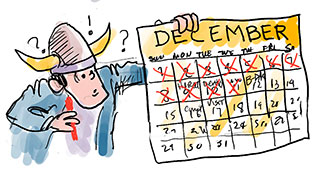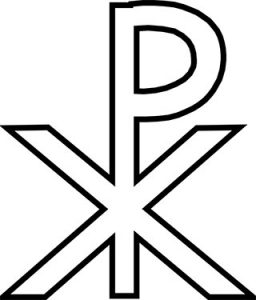Who first celebrated Christmas on December 25th? What does a “dreidel” mean in Yiddish? These and more are in our new Global Holiday Trivia game, Part 2.
Christmas Trivia

Start
Congratulations!
You have completed Christmas Trivia.

You scored %%SCORE%% out of a possible 5 points.
Your performance was: %%RATING%%
Your answers are highlighted below.
Question 1 |

Name the empire, nation, or city state that first celebrated Christmas on December 25th
A | Athens |
B | Norway |
C | Rome |
D | Sweden |
E | The U.S. |
Question 1 :
C. Rome
The first recorded date of the celebration of Christmas was on December 25th in 336, during the time of the Roman Emperor Constantine (he was the first Christian Roman Emperor). Christmas evolved from the Roman Festival of Saturnalia, which took place between December 17th and the 25th, honoring Saturn, the Roman God of Agriculture. Many of the traditions of Saturnalia were transitioned into Christmas: work and business came to a halt, schools and courts of law closed, and the normal social patterns were suspended. People decorated their homes with wreaths and other greenery, and shed their traditional togas in favor of colorful clothes known as synthesis. Even slaves did not have to work during Saturnalia, but were allowed to participate in the festivities; in some cases, they sat at the head of the table while their masters served them. Romans spent Saturnalia gambling, singing, playing music, feasting, socializing and giving each other gifts. Wax taper candles called cerei were common gifts during Saturnalia, to signify light returning after the solstice. On the last day of Saturnalia celebrations, known as the Sigillaria, many Romans gave their friends and loved ones small terracotta figurines known as signillaria, which may have referred back to older celebrations involving human sacrifice.
The first recorded date of the celebration of Christmas was on December 25th in 336, during the time of the Roman Emperor Constantine (he was the first Christian Roman Emperor). Christmas evolved from the Roman Festival of Saturnalia, which took place between December 17th and the 25th, honoring Saturn, the Roman God of Agriculture. Many of the traditions of Saturnalia were transitioned into Christmas: work and business came to a halt, schools and courts of law closed, and the normal social patterns were suspended. People decorated their homes with wreaths and other greenery, and shed their traditional togas in favor of colorful clothes known as synthesis. Even slaves did not have to work during Saturnalia, but were allowed to participate in the festivities; in some cases, they sat at the head of the table while their masters served them. Romans spent Saturnalia gambling, singing, playing music, feasting, socializing and giving each other gifts. Wax taper candles called cerei were common gifts during Saturnalia, to signify light returning after the solstice. On the last day of Saturnalia celebrations, known as the Sigillaria, many Romans gave their friends and loved ones small terracotta figurines known as signillaria, which may have referred back to older celebrations involving human sacrifice.
Question 2 |

The name ‘dreidel’ is from a Yiddish word which means?
A | Dedication |
B | Education |
C | Game |
D | Inauguration |
E | Spin |
Question 2 :
E. Spin
The dreidel (from a Yiddish word meaning "to spin") is also called in Hebrew a "sevivon" (meaning "to turn around"). It is used in a popular Hanukkah gambling game. The four-sided top has a different Hebrew letter on each side: nun (נ), gimel (ג), hei (ה), and shin (ש). These letters stand for the phrase "nes gadol hayah sham," which translates to "a great miracle happened there." In Israel, the phrase is "nes gadol hayah po," which translates to "a great miracle happened here," and the shin is replaced with a pey (פ) on the dreidel.
The dreidel (from a Yiddish word meaning "to spin") is also called in Hebrew a "sevivon" (meaning "to turn around"). It is used in a popular Hanukkah gambling game. The four-sided top has a different Hebrew letter on each side: nun (נ), gimel (ג), hei (ה), and shin (ש). These letters stand for the phrase "nes gadol hayah sham," which translates to "a great miracle happened there." In Israel, the phrase is "nes gadol hayah po," which translates to "a great miracle happened here," and the shin is replaced with a pey (פ) on the dreidel.
Question 3 |
What nation introduced the Christmas tree to the U.S.?
A | Britain |
B | Germany |
C | Italy |
D | Norway |
E | Sweden |
Question 3 :
B. Germany
The history of Christmas trees goes back to the symbolic use of evergreens in ancient Egypt and Rome. Germany is credited with starting the Christmas tree tradition of bringing decorated trees into their homes, generally wiring its branches with lighted candles, in the 16th century. Some built Christmas pyramids of wood and decorated them with evergreens and candles if wood was scarce. Most 19th-century Americans found Christmas trees an oddity. The first record of one being on display was in the 1830s by the German settlers of Pennsylvania. The Pennsylvania-German settlements had community trees as early as 1747. But, as late as the 1840s Christmas trees were seen as pagan symbols and not accepted by most Americans. In 1846, Queen Victoria and German Prince, Albert, were sketched in the Illustrated London News standing with their children around a Christmas tree. Unlike the previous royal family, Victoria was very popular with her subjects, and what was done at court immediately became fashionable—not only in Britain, but with fashion-conscious East Coast American Society. By the 1890s, Christmas ornaments were arriving from Germany and Christmas tree popularity was on the rise around the U.S. It was noted that Europeans used small trees about four feet in height, while Americans liked their Christmas trees to reach from floor to ceiling.
The early 20th century saw Americans decorating their trees mainly with homemade ornaments, while the German-American sect continued to use apples, nuts, and marzipan cookies. Popcorn joined in after being dyed bright colors and interlaced with berries and nuts. Electricity brought about Christmas lights, making it possible for Christmas trees to glow for days on end. With this, Christmas trees began to appear in town squares across the country and having a Christmas tree in the home became an American tradition.
The history of Christmas trees goes back to the symbolic use of evergreens in ancient Egypt and Rome. Germany is credited with starting the Christmas tree tradition of bringing decorated trees into their homes, generally wiring its branches with lighted candles, in the 16th century. Some built Christmas pyramids of wood and decorated them with evergreens and candles if wood was scarce. Most 19th-century Americans found Christmas trees an oddity. The first record of one being on display was in the 1830s by the German settlers of Pennsylvania. The Pennsylvania-German settlements had community trees as early as 1747. But, as late as the 1840s Christmas trees were seen as pagan symbols and not accepted by most Americans. In 1846, Queen Victoria and German Prince, Albert, were sketched in the Illustrated London News standing with their children around a Christmas tree. Unlike the previous royal family, Victoria was very popular with her subjects, and what was done at court immediately became fashionable—not only in Britain, but with fashion-conscious East Coast American Society. By the 1890s, Christmas ornaments were arriving from Germany and Christmas tree popularity was on the rise around the U.S. It was noted that Europeans used small trees about four feet in height, while Americans liked their Christmas trees to reach from floor to ceiling.
The early 20th century saw Americans decorating their trees mainly with homemade ornaments, while the German-American sect continued to use apples, nuts, and marzipan cookies. Popcorn joined in after being dyed bright colors and interlaced with berries and nuts. Electricity brought about Christmas lights, making it possible for Christmas trees to glow for days on end. With this, Christmas trees began to appear in town squares across the country and having a Christmas tree in the home became an American tradition.
Question 4 |
What nation originated Boxing Day?
A | Australia |
B | Britain |
C | Canada |
D | Germany |
E | Italy |
Question 4 :
B. Britain
Boxing Day takes place on December 26th and is only celebrated in a few countries; mainly ones historically connected to the UK, such as Canada, Australia, South Africa and New Zealand. ) In Germany it is known as "Zweite Feiertag” (which means 'second celebration'). It was started in the UK about 800 years ago, during the Middle Ages. It was the day when the alms box, collection boxes for the poor often kept in churches, were traditionally opened so that the contents could be distributed to poor people. Some churches still open these boxes on Boxing Day. It might have been the Romans, who introduced Christianity to Britannia, who first brought this type of collecting box to the UK. In The Netherlands, some collection boxes were made out of a rough pottery called 'earthenware' and were shaped like pigs. Perhaps this is where we get the term 'Piggy Bank.' It was also traditional that servants got the day off to celebrate Christmas with their families on Boxing Day. Before World War II, it was common for working people (such as milkmen and butchers) to travel round their delivery places and collect their Christmas box or tip. This tradition has now mostly stopped and any Christmas tips, given to people such as postal workers and newspaper delivery children, are not normally given or collected on Boxing Day.
Boxing Day takes place on December 26th and is only celebrated in a few countries; mainly ones historically connected to the UK, such as Canada, Australia, South Africa and New Zealand. ) In Germany it is known as "Zweite Feiertag” (which means 'second celebration'). It was started in the UK about 800 years ago, during the Middle Ages. It was the day when the alms box, collection boxes for the poor often kept in churches, were traditionally opened so that the contents could be distributed to poor people. Some churches still open these boxes on Boxing Day. It might have been the Romans, who introduced Christianity to Britannia, who first brought this type of collecting box to the UK. In The Netherlands, some collection boxes were made out of a rough pottery called 'earthenware' and were shaped like pigs. Perhaps this is where we get the term 'Piggy Bank.' It was also traditional that servants got the day off to celebrate Christmas with their families on Boxing Day. Before World War II, it was common for working people (such as milkmen and butchers) to travel round their delivery places and collect their Christmas box or tip. This tradition has now mostly stopped and any Christmas tips, given to people such as postal workers and newspaper delivery children, are not normally given or collected on Boxing Day.
Question 5 |

What nation spells Christmas as 'Xmas?'
A | Estonia |
B | Greece |
C | Denmark |
D | Portugal |
E | Uruguay |
Question 5 :
B. Greece
Some people think it's incorrect to call Christmas, 'Xmas,' as it takes the 'Christ' (Jesus) out of Christmas. But that is not correct! In the Greek language and alphabet, the letter that looks like an X is the Greek letter chi / Χ (pronounced 'kye' - it rhymes with 'eye') which is the first letter of the Greek word for Christ, Christos. The early church used the first two letters of Christos in the Greek alphabet 'chi' and 'rho' to create a monogram (symbol) to represent the name of Jesus. This looks like an X with a small p on the top: ☧
Some people think it's incorrect to call Christmas, 'Xmas,' as it takes the 'Christ' (Jesus) out of Christmas. But that is not correct! In the Greek language and alphabet, the letter that looks like an X is the Greek letter chi / Χ (pronounced 'kye' - it rhymes with 'eye') which is the first letter of the Greek word for Christ, Christos. The early church used the first two letters of Christos in the Greek alphabet 'chi' and 'rho' to create a monogram (symbol) to represent the name of Jesus. This looks like an X with a small p on the top: ☧
Once you are finished, click the button below. Any items you have not completed will be marked incorrect.
Get Results
There are 5 questions to complete.
You have completed
questions
question
Your score is
Correct
Wrong
Partial-Credit
You have not finished your quiz. If you leave this page, your progress will be lost.
Correct Answer
You Selected
Not Attempted
Final Score on Quiz
Attempted Questions Correct
Attempted Questions Wrong
Questions Not Attempted
Total Questions on Quiz
Question Details
Results
Date
Score
Hint
Time allowed
minutes
seconds
Time used
Answer Choice(s) Selected
Question Text
All done
Deplorable! You need to travel more! This is pathetic!
Deplorable! You need to travel more! This is pathetic!
Embarrassing! Keep trying! We know you're better than that. Play the game again.
Not that bad! But not good either. Play the game again.
Pretty good ... but not perfect.
Perfect! Are you brilliant traveler or what?
